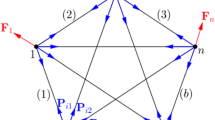Abstract
We are concerned with the computational topological optimization of elastic structures, in particular minimization of compliance subject to a constraint on the mass. Through computational experiments, it is discovered that even very simple optimization problems can exhibit complex behavior such as critical points and bifurcation. In the vicinity of critical points, structural topology optimization problems are not well-posed since infinitesimally small perturbations lead to distinct topologies.
















Similar content being viewed by others
References
Baier H (1994) Ill posed problems in structural optimization and their practical consequences. Struct Optim 7:184–190
Bendsoe MP, Sigmund O (2003) Topology Optimization Theory, Methods, and Applications. Springer, Berlin
Blanchard P, Devaney RL, Hall GR (2006) Differential Equations. Thomson Brooks/Cole, USA
Cheng G, Lui X (2011) Discussion on symmetry of optimum topology design. Struct Multidisc Optim 44:713–717
Guo X, Ni C, Cheng G, Du Z (2012) Some symmetry results for optimal solutions in structural optimization. Struct Multidisc Optim 46:631–645
Kosakam I, Swan CC (1999) A symmetry reduction method for continuum structural topology optimization. Comp Struct 70:47–61
Lazarov B, Sigmund O (2011) Filters in topology optimization based on Helmholtz-type differential equations. Int J Numer Meth Eng 86:765–781
Richardson JN, Adriaenssens S, Bouillard P, Coelho RF (2013) Symmetry and asymmetry of solutions in discrete variable structural optimization. Struct Multidisc Optim 47:631–643
Rozvany G (1998) Exact analytical solutions for some popular benchmark problems in topology optimization. Struct Optim 15:42–48
Rozvany GIN (2011) On symmetry and non-uniqueness in exact topology optimization. Struct Multidisc Optim 43:297–317
Sigmund O (2001) A 99 line topology optimization code written in matlab. Struct Multidis Optimiz 21:120–127
Stolpe M (2010) On some fundamental properties of structural topology optimization problems. Struct Multidisp Optim 41:661–670
Wächter A, Biegler LT (2006) On the implementation of a primal-dual interior point filter line search algorithm for large-scale nonlinear programming. Math Program 106(1):5–57
Author information
Authors and Affiliations
Corresponding author
Additional information
Responsible Editor: Fred van Keulen
Publisher’s Note
Springer Nature remains neutral with regard to jurisdictional claims in published maps and institutional affiliations.
Prepared by LLNL under Contract DE-AC52-07NA27344
Rights and permissions
About this article
Cite this article
White, D.A., Voronin, A. A computational study of symmetry and well-posedness of structural topology optimization. Struct Multidisc Optim 59, 759–766 (2019). https://doi.org/10.1007/s00158-018-2098-9
Received:
Revised:
Accepted:
Published:
Issue Date:
DOI: https://doi.org/10.1007/s00158-018-2098-9




